
Welcome to the CD Version of the Third edition of Perera's Telegraph
Collectors Guide. This no-frills CD version is designed for easy and
instantaneous access to the high resolution versions of all of the photographs
and information in the printed book. I hope you will find it useful. 73 -
Tom.
The printed and/or CD version of this book
may be ordered - from:
ARTIFAX BOOKS. Box 88, Maynard, MA 01754
http://www.artifaqxbooks.com
OR: See http://w1tp.com for more information.
Copyright (c) 2006, Tom Perera Ph.D.: You are welcome to use the information
and images in this CD version of my book for your own personal enjoyment.
Commercial users must contact Tom Perera
(email keys@w1tp.com) for permissions.
Please email corrections to the author at:
keys@w1tp.com.
Please inquire before sending attachments larger than 100KB.
( Click GO BACK to return to PREVIOUS SELECTION. )
( SCROLL DOWN to go on to NEXT SECTION OF BOOK. )
Click HERE to return to TABLE OF CONTENTS.
Click HERE to return to Main CD Menu.
INTRODUCTION
This guide is designed to serve as an inexpensive, portable, and comprehensive source of basic information and reference material for new and experienced collectors. As an additional aid to serious collectors and historians, detailed descriptions and color photographs of over 5000 telegraph and related items may be found on this CD and in my Internet Telegraph Museum: http://w1tp.com
ACKNOWLEDGMENTS
I am indebted to the scholars of telegraph history for most of the information in this book. My special thanks to the late Louise Moreau - W3WRE, whose efforts provided a clear time-line of the evolutionary changes in telegraph key design.
I would also like to thank (in alphabetical order): Lynn Burlingame, John Casale, Randy Cole, John Elwood, Tom French, Bill Holly, John Kelly (Silent Key), Russ Kleinman, Jim Kreuzer, Pete Malvasi, Neal McEwen, Larry Nutting, David Pennes, Greg Raven, Roger Reinke, Gil Schlehman, Doug Seneker, Ed White, Murray Willer (SK), and John Williams: all fine telegraph collectors and historians.
Special thanks to those who have allowed me to include photographs of their keys and information that they have laboriously gathered. Bill Holly and "Mitch" Mitchell have graciously allowed me to use many photographs from The Vibroplex Book. Tom French has allowed me to use illustrations and info. from his Vibroplex and McElroy books. Roger Reinke has allowed me to use his important list of Early American Telegraph Equipment Manufacturers. Neal McEwen has let me use his digitization of Roger’s list, his Military Manufacturer’s Code list, and his list of Bug Manufacturers. Doug Seneker has let me use his extensive Bug List. Larry Nutting has allowed me to excerpt information from his book on Military J-Series Keys.
The many collectors who have allowed me to use photographs of their keys are identified at the end of each description. The Bibliography, Periodicals, and Internet Links sections near the end of this book give more information about how to find these & other materials, books, lists, and collections. Updates at: http://w1tp.com
NOTES ON PRICES
Although, in general, the OLDER and RARER an item is, the more it is worth, most buyers and sellers simply don’t know what telegraph items are worth. Despite their historical and scientific significance, telegraph items are among the few remaining "undiscovered" collectibles. They are not even mentioned in most Antique Collector’s Guides. Consequently, the prices paid for telegraph items range from the one or two dollars paid at junk sales to the tens of thousands paid by wealthy and knowledgeable collectors caught-up in bidding frenzies at auctions.
I have chosen to eliminate both ends of this continuum and show the "MEDIAN" or "Most Commonly Paid" prices at auctions, hamfests, antique shows, flea markets, and private and public sales. These MEDIAN prices are the prices that an experienced and auction- savvy collector would readily pay for an item in 2006. The MEDIAN is a value that represents the MIDDLE of the prices paid for similar items. The MEDIAN, unlike the Mean, is Not affected by a few Very High or Very Low priced sales. The MEAN (also called the AVERAGE) is Not being used because it is dramatically influenced by a few Very High or Very Low Priced sales. This price guide is designed to show the "typical" price of an item but not unusual or extreme prices. For example: If a particular model of key is sold in 5 different sales for $100, $100, $100, $100, and at an auction for $3,000, The MEDIAN of these 5 sales is $100 but the MEAN (AVERAGE) is $680 !
The quoted prices are for items in "AVERAGE" CONDITION with ALL of the ORIGINAL PARTS and MOST of the ORIGINAL FINISH. No parts are broken. For items in MINT condition, add about 15% to the listed value. For items that are in poor condition or that have been "RESTORED" by using wire brushes, steel wool, files, pliers, polish, or paint, subtract about 30%. Since parts for old telegraph items are impossible to find and must be hand-made, subtract an additional 50% for major ...and 30% for minor missing parts. See my Notes on the importance of CAREFULLY Restoring Items and: PLEASE DON’T WIRE- BRUSH or "POLISH" !!
NOTE: Recent Internet auction prices have encouraged sellers to bring out thousands of telegraph items. This has led to a gradual decrease in prices. Despite this trend, the RELATIVE values of the keys in this book remain constant. (Low value keys continue to remain PROPORTIONALLY low in value with respect to high value keys despite the shift in the overall price base.)
The LATEST (Downloadable) REVISION OF THE PRICE LIST WILL
ALWAYS BE POSTED IN MY INTERNET MUSEUM: http:// w1tp.com
HOW TO USE THIS GUIDE
OVERVIEW: This guide is designed to serve as a source of general and specific information about telegraph instruments and their current values. The detailed 1200 entry cross-referenced INDEX (Pages 88-97), the newly updated EARLY AMERICAN TELEGRAPH MANUFACTURER’S List (Pages 66-70), and the newly updated BUG MAKERS and BUG NAME Lists are the primary reference aids.
ORGANIZATION OF THIS GUIDE:
The first section of the guide provides a brief history of the development of telegraph apparatus. It includes labeled pictures and general descriptions to help illustrate the major types of instruments. The main section is organized from Oldest-to-Newest. It contains pictures, descriptions, and comments about 300 keys. Later sections provide more information about keys, books, periodicals, & internet links which should help answer virtually any telegraph related questions. The final section is the price guide.
IDENTIFICATION OF SPECIFIC INSTRUMENTS:
First, determine which type of instrument you are trying to identify. Use the first section of the guide and match your item to the pictures and descriptions until you are certain that it is either a key or a sounder or a relay, etc. and what it’s approximate age is. Then search the cross-referenced INDEX on pages 88-97 and the EARLY TELEGRAPH MANUFACTURER’S List on pages 66-70 as well as the BUG MAKERS and BUG NAME Lists for the name of the manufacturer if it carries a maker’s name. Look at the various items made by that manufacturer and try to find yours. If you find it, read the description and use its (number) to look up the current value and the number of its color photograph on the internet. If you can’t find what you are looking for, see if you can find something similar in the guide, or search the entire 3,000+ item internet telegraph museum at: http://w1tp.com
USE THE GUIDE TO HELP YOU MAKE BUYING DECISIONS:
To help you determine how much to pay for a telegraph instrument, find it, or a similar item in the guide as described above and look up its value. Then determine whether it is in average condition with all parts and labels. If it is better or worse than average, adjust the listed value appropriately. Finally, you must make your own decision about whether to offer more or less than the average value based on how badly you want the item. Good places to look for telegraph items include: hamfests, antique shows/shops, flea markets, auctions, the internet, and, it often pays to place advertisements in local newspapers and classified buyers’ and sellers’ magazines.
USE THE GUIDE TO HELP YOU SELL:
To help determine how much to ask for a particular item, find it or a similar item in the guide and look up its value. Then determine whether it is in average condition with all parts and labels. If it is better or worse than average, adjust the listed value appropriately. Finally, you must make your own decision about how badly you need to sell the item and adjust the price you are asking accordingly. Good ways to sell telegraph items include directly contacting telegraph collectors through their web pages on the internet, and finding collectors in published antique guides. Local and national hamfests are attended by many thousands of ham radio operators, many of whom collect telegraph keys. Internet auctions are also productive.
USE THE GUIDE FOR INSURANCE AND ESTATE APPRAISALS:
Most insurance companies require that you have a collection appraised before they will agree to insure it. Using the guide, list the items in your collection and their values to establish the overall value of your collection. I suggest that you photograph your collection as additional proof in the event that you lose items in a fire or theft. For a formal appraisal, contact any of the major telegraph collectors. They will use this guide and formally sign the appraisal for you.
HISTORICAL BACKGROUND
Since the beginnings of recorded time, people have been trying to find ways to communicate over distances that were greater than the human voice could carry. Early smoke signals, signal fires, signal lamps, and signal flags eventually led to the development of semaphores. In the 1830's, France had established semaphores on every available hill throughout the country. They allowed messages to be sent across the country in mere hours rather than the weeks it had taken to hand carry them.
Samuel F. B. Morse:
The United States was in the process of considering the installation of a similar country-wide semaphore system when Samuel Finley Breese Morse convinced Congress to fund a demonstration of his new "Electric telegraph" between Baltimore and Washington. His successful demonstration before Congress in 1844 revolutionized communication, allowed messages to be sent over vast distances in the blink of an eye, and was one of the most important inventions of the 19th century.
Electrical Telegraph Circuit Components:
Morse's "Land-line" telegraph system consisted of an electrical circuit with 2-3 "batteries" to supply the electricity, a "key" to control current flow through the circuit, and a "register" to make marks on a paper tape when the circuit had been activated. In practice, the key and register were connected by a long SINGLE WIRE supported by telegraph poles. The EARTH itself completed the electrical circuit as shown in the following diagram: These circuits across the land were called "land-line" circuits.
WIRE on telegraph poles
!-->---->---->---->---->---->---->---->---->BATTERIES--->---->----->-!
! (Supply the Voltage) !
KEY REGISTER
(Completes or breaks (Electromagnet
the electric circuit.) Marks a paper tape.)
! !
!--(----(----(----(----(----(----(----(----(----(----(---(----(----(-!
(The EARTH completes the circuit.)
Morse Code and the Continental / International Code:
Morse's "code" for each letter of the alphabet consisted of a series of short electrical signals (dots), and long electrical signals (dashes). His code has been used on the American land-lines to the present day, and is called the "Morse Code" or "American Morse Code". This code was modified to eliminate spaces within characters and extra-long dashes, and used in Europe, and on the intercontinental submarine telegraph cables, and on the radio waves. This modified code is called the "Continental" or "International" Code.

The "Crow’s Foot" or "Gravity" Battery:
Most telegraph systems used 2-3 or more batteries that had a crow’s-foot shaped zinc electrode and a star shaped copper electrode immersed in a blue vitriol (copper sulfate) solution. Longer telegraph lines and dry soil conditions required the use of more batteries in series connection so that their individual voltages were added. Each battery produced about 1.5-2 volts. [1]

The Key:
The telegraph key started as a simple "strap key" consisting of a springy strip of metal, and gradually evolved into a well-balanced, pivoted, refined device as shown.
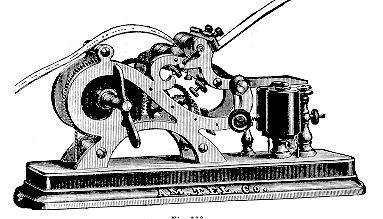
The Register:
Registers started as weight-driven clockwork devices which pulled a paper tape across an embossing stylus that marked the dots and dashes onto the tape (shown). They gradually evolved into spring-driven clockwork mechanisms with ink pens marking the tape.

The Sounder Replaces the Register:
Shortly after Morse's 1844 Congressional demonstration, telegraphers discovered that the register made noises as it wrote the dots and dashes on the paper tape and they found that they could "copy" the characters by ear. Around the time of the Civil War, a new device called a "sounder" which made click sounds with its armature when its coils were activated (or deactivated) by about 3-6 volts, gradually replaced most of the early registers although some people continued to distrust "Copy-By-Ear". Telegraph operators learned to discriminate the time between the (quite different) pull-in and release sounds and used this time to identify dots or dashes.
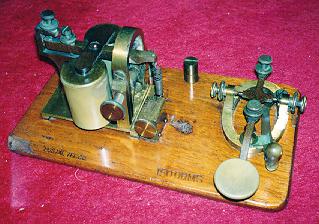
The KOB ( Key [and Sounder] on Base ):
Sounders were small enough to allow them to be mounted on the same wooden base as the telegraph key. Portable key-and-sounder combination sets called "KOB's" (Key [with sounder] on Base ) became popular before, during, and after the Civil War because telegraphers could carry them with them. Tiny pocket-sized key and sounder sets were also developed and used by linemen and Civil War spies. They were called "Pocket Sets" or "Pocket Relays" (See item 90). Keys and sounders on cast iron bases were often used inside private homes and called "Private Line Sets".

The Relay:
To help strengthen the electric current in very long telegraph lines, a very sensitive "relay" was used part way along the line. It's horizontally mounted coils could be adjusted to detect even tiny voltages in the incoming line and to operate a set of contacts that switched the voltages in the next part of the line. Relays were very important for all long distance lines.
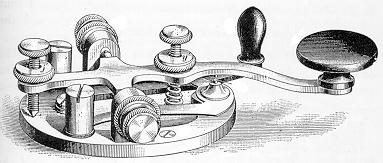
The Bunnell "Triumph Key":
The explosive growth of telegraph land-line communications after 1844 led to interesting "improvements" in telegraph key design which culminated in the "Triumph Key" patented in 1881 by Jesse Bunnell, a telegraph equipment manufacturer. The all-steel lever of Bunnell's "Triumph Key" solved the problem which affected all of the earlier key designs in which the lever would come loose from the press-fit trunnion pin and slide back and forth, left-to-right, making the key useless.
1881: An Important Year: The "Triumph Key"
As Bunnell predicted, his "Triumph Key" was an instantaneous success that made all previous designs obsolete. Hundreds of thousands of them were made from 1881 to the present. Thus, 1881 IS A VERY IMPORTANT DATE TO REMEMBER because most keys made AFTER 1881 are so common as to have virtually no value and keys made BEFORE 1881 are generally rare and valuable.
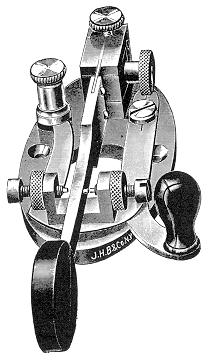
The "Sideswiper":
As telegraphers began to work longer and longer hours sending fast code with up and down movements of the telegraph keys, many began experiencing severe pains in their wrists which they called "Telegrapher’s Paralysis". "Telegrapher’s Cramp", or "Glass Arm" (We now call it Carpal Tunnel Syndrome). In 1888 Jesse Bunnell invented a key that used a side-to-side movement and named it a "Sideswiper" or "Double-Speed key". It virtually eliminated "Telegrapher’s Paralysis", and became very popular. They were still being made in the 1950s. Historian John Casale-W2NI has presented convincing evidence that this key was actually invented and patented after 1900.
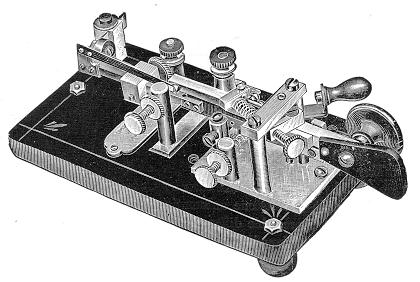
The Semi-Automatic Key or "Bug".
Another landmark in telegraph key design was the invention in 1904, of "automatic" (technically: "semi-automatic") keys or "bugs". which could make dots automatically and therefore produce a dramatic increase in the speed at which code could be sent.

Spark, Wireless, and Radio Keys:
The tiny electrical contacts used by the land-line keys were unable to handle the high currents of Marconi's 1910 spark transmitters, and later wireless transmitters and radio transmitters. Special spark keys with huge electrical contacts (usually made of silver) were designed and used. As improvements in radio design allowed, the contacts were gradually reduced in size but remained larger than the pencil-lead sized (1/16 - 1/32 inch) contacts of the land-line keys.
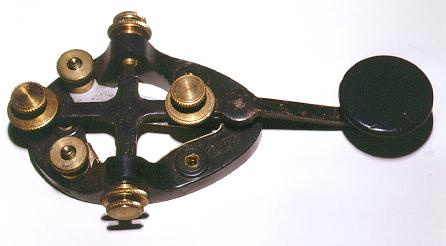
Military Keys:
As the Military began using radio to replace land-line communications, specialized military keys were manufactured in great numbers and tens of thousands appeared on the war surplus market after the end of the wars in which they had been used. Ham radio operators bought up most of these keys for their own use.
The apparatus which was used for early telegraphic communication has great historical importance and many instruments are valuable collector's items. However, some apparatus such as post 1881 land-line and WW-II military keys were made in such large quantities as to be virtually worthless to collectors. This guide is designed to assist in the identification and appraisal of all types of telegraph instruments. For further information, please visit my internet on-line museum with over 3,000 descriptions and color photographs and lots of other information: http://w1tp.com
TELEGRAPH KEY LEVER SHAPES:
These are the shapes of the levers used on keys during different historical periods.
American Pre-"Triumph Key" Morse land
line keys. (1844-1881)
(Also used in MOST European and other Foreign
keys)
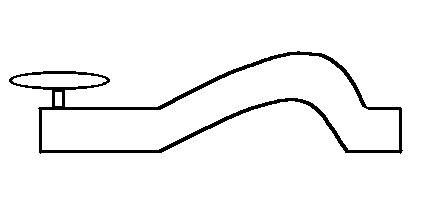
American Pre-"Triumph Key" Morse land
line keys. (1848-1881)
(Also a few German keys)
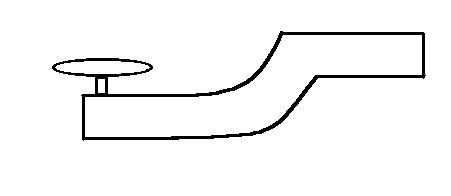
STEP LEVER: (Brass or Nickel-Plated Brass)
American Pre-"Triumph Key" Morse land
line keys. (1850’s-1881)
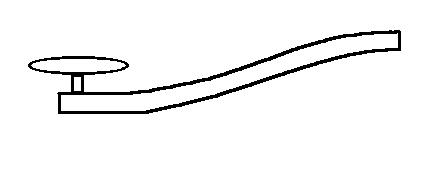
CURVED LEVER: (Flat Steel)
"Triumph-Key" Style: American Keys of
All Types. (1881 - present)